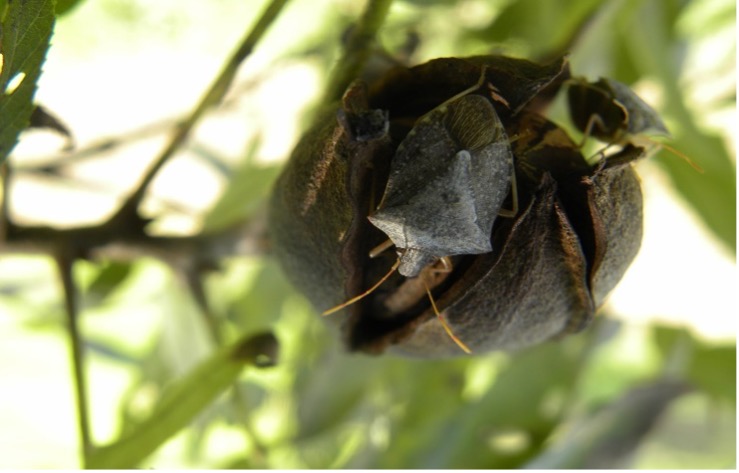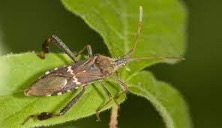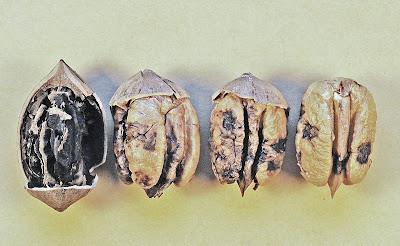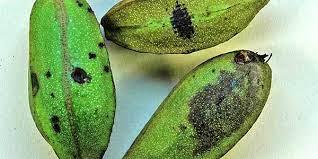Don’t Forget Late Season Pecan Pests
This is the time of season when pecan producers are in harvest mode realizing the rewards of a long season. However, this can be one of the most difficult times for late season management. Given the challenges of final kernel fill, harvest timing, wildlife depredation, and marketing, this is also a time when growers must potentially deal with late-season insect pests such as pecan weevil and aphids. Other late-season pests, (stink bugs and leaffotted bugs), can also be especially challenging (Fig. 1-3).
| Image | Caption | |
|---|---|---|
 |
Figure 1. Southern Green Stink bug. (LSU) | |
 |
Figure 2. Brown Stink bug. (Pecan South) | |
 |
Figure 3. Leaffooted bug. (OSU) |
There is nothing more frustrating for a grower than to discover at harvest that they have significant stink bug and leaffooted bug damage. Damaged kernels are pecans that producers have put a lot of money, time, and effort into producing. The tree exhausts a lot of energy to develop these kernels, yet you don’t get paid for these pecans.
Preventing damage and controlling stink bugs and leaf-footed bugs come with several challenges. First, there are no treatment thresholds and scouting large trees can be difficult. In addition, damage can occur up to and during harvest. Finally, these insects are strong fliers that can easily move into orchards and groves from surrounding host plants. Host plants can include various species of weeds, such as thistle, and cultivated crops such as cowpeas, cotton, corn, soybean, millet, grain sorghum, and alfalfa. As the season for these crops comes to an end, stink bugs and leaf-footed bugs search for other food sources.
As seen above, several species of Hemiptera can cause kernel feeding. The green stink bug, Nezara viridula (L), brown stink bug, Euschistus servus (Say), and leaffooted bug Leptoglossus phyllopus (L) are three species of kernel feeding insects that are commonly associated with pecans. Stink bugs do not reproduce on pecans, so adults must move in from surrounding areas.
The damage caused by these insects is nut-drop during the water stage and black spots on kernels (Kernel Spot) at harvest (Fig. 4). Damage from stink bug and leaffooted bug can be masked by scab damage (Fig. 5). Unfortunately, most producers do not realize the kernel damage until harvest. For producers that sell wholesale, this damage can result in a reduced price for the crop, and for those producers that retail, it can result in unhappy customers.
| Image | Caption | |
|---|---|---|
 |
Figure 4. Far left pecan shows damage during water stage. Pecans 2-4 denotes (Kernel Spot) damage. (Northern Pecan) |
|
 |
Figure 5. Pecan Scab, Stink bug and Leaffooted bug damage. (Af-Fax) |
Although difficult to manage, there are several things that growers can do to combat these pests.
- Elimination of weed host within and around the orchard.
- Control of insect populations in the host crop, if possible, before they move into the orchard, and treating border areas.
- Trap crops can be utilized to draw these insects into a small planting of row crops where control can be implemented on a smaller scale.
- Utilization of insecticide for other late season pests (such as pecan weevil) can help with control.
- Damage can occur past shell hardening, so continued monitoring is imperative until the crop is harvested.
- Any late season applications must be made with harvest in mind. Choose insecticides carefully. Depending on the product, pre-harvest interval (PHI) can range from 3-21 days.
Stink bug and leaffooted bug management is a challenge, but by learning about the pest complex, their food hosts, and movement, you will have a better chance at preventing serious losses during harvest.
For more information on pecan insect pest management options go to EPP CR-6209, Commercial Pecan Insect and Disease Control.
